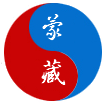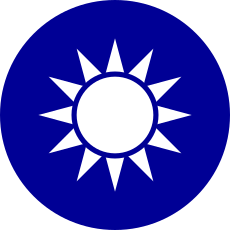Mongolian and Tibetan Affairs Commission
|
蒙藏委員會 Měng-Zàng Wěiyuánhuì | |
 | |
| Agency overview | |
|---|---|
| Formed |
April 1912 (as Mongolian and Tibetan Affairs Agency) 1 February 1929 (as MTAC) |
| Jurisdiction |
|
| Headquarters | Zhongzheng, Taipei |
| Agency executive |
|
| Parent agency | Executive Yuan |
| Website | www.mtac.gov.tw (English) |

The Mongolian and Tibetan Affairs Commission (MTAC; Chinese: 蒙藏委員會; pinyin: Měng-Zàng Wěiyuánhuì) is one of two ministry-level commissions of the Executive Yuan in the Republic of China. Inaugural addresses are delivered by the Chairman of the Commission.[1]
History

It was originally created during the Qing Dynasty in 1636 as Mongolian Bureau as a subsection of the Lifan Yuan, and oversaw the relationship of the Qing court to its Mongolian and Tibetan dependencies. During Kangxi Emperor rule, the bureau was renamed to Minority Affairs Council and renamed again to Ministry of Minority Affairs under Guangxu Emperor rule.
Following the 1911 revolution and collapse of the Qing dynasty, the section was replaced by Mongolian and Tibetan Affairs Agency under the Ministry of the Interior in April 1912. In July 1912, the agency was again renamed as Bureau of Mongolian and Tibetan Affairs and placed under the State Affairs Yuan. In 1914, it was reorganized and being placed directly under the supervision of President. On 1 February 1929, it was finally changed to Mongolian and Tibetan Affairs Commission (MTAC) with accordance to the Nationalist Government Organizational Law.[2] After the Communist revolution in China, and the Republic of China's relocation to Taiwan, the MTAC ceased its activities in Tibet and Mongolia, although it served as a governmental body which assisted in the relationship between ethnic Mongols and Tibetans in Taiwan and increasing the communication between the Taiwanese and the Mongols as well as the Tibetans.[1]
After the 1959 Tibetan Rebellion, Chiang Kai-shek announced in his Letter to Tibetan Compatriots (Chinese: 告西藏同胞書; pinyin: Gào Xīzàng Tóngbāo Shū) that the ROC's policy would be to help the Tibetan diaspora overthrow the People's Republic of China's rule in Tibet. The MTAC sent secret agents to India to disseminate pro-Kuomintang (KMT) and anti-Communist propaganda among Tibetan exiles. From 1971 to 1978, the MTAC also recruited ethnic Tibetan children from India and Nepal to study in Taiwan, with the expectation that they would work for a ROC government that returned to the mainland. In 1994, the veterans' association for the Tibetan guerrilla group Chushi Gangdruk met with the MTAC and agreed to the KMT's One China Principle. In response, the Dalai Lama's Central Tibetan Administration forbade all exiled Tibetans from contact with the MTAC.[3]
Organizational structure
- Commissioners
- Secretary's Office
- Counselor's Office
- Department of Mongolian Affairs
- Department of Tibetan Affairs
- Department of General Affairs
- Compilation and Translation
- Accounting Office
- Personnel Office
- Civil Service Ethics Office
Chairpersons
.jpg)
- Yan Xishan (1928.12.27 – 1930.04.05)
- Ma Fuxiang (1930.09.08 – 1931.12.30)
- Shi Qingyang (1931.12.30 – 1935.03.15)
- Huang Mu-sung (1935.03.15 – 1936.07.29)
- Lin Yun Gai (1936.07.29 – 1936.08.08)
- Wu Zhongxin (1936.08.08 – 1944.12.06)
- Leung Kam Lo (1944.12.06 – 1947.04.23)
- Xu Shiying (1947.04.23 – 1948.11.26)
- Bai Yunti (1948.11.26 – 1949.06.06)
- Guan Jiyu (1949.06.06 – 1949.11.23)
- Zhou Kuntian (1949.11.23 – 1950.03.10)
- Yu Jingtang (1950.03.10 – 1951.02.22)
- Jiong Tian Jin (1951.02.22 – 1954.05.25)
- Liu Lianke (1954.05.25 – 1658.07.14)
- Lee Yong-xin (1958.07.14 – 1960.05.30)
- Jiong Tian Jin (1960.05.30 – 1963.12.14)
- Guo Qiqiao (1963.12.14 – 1972.5.29)
- Chui Yan Cui (1972.05.29 – 1981.11)
- Xie Renyang (1981.11 – 1984.05)
- Dongshu Fan (1984.05 – 1986.03)
- Wu Hua-peng (1986.04 – 1993)
- Jun Zhang Yi (1993–1994)
- Lee Hou-kao (1994–1997)
- Kao Koong-lian (1997–2000)
- Hsu Cheng-kuang (2000–2002)
- Hsu Chih-hsiung (2002–2008)
- Kao Su-Po (2008.5.20 – 2011.02.08)
- Luo Ying-shay (2011.02.09 – 2013.09.29)
- Chen Ming-jen (2013.09.30 - 2013.10.22) (acting)
- Jaclyn Tsai (2013.10.22 – 2016.05.19)
- Lin Mei-chu (2016.05.20 – incumbent)
Other Members
Mongolian and Tibetan Cultural Center

The Mongolian and Tibetan Affairs Commission manages the Mongolian and Tibetan Cultural Center (Chinese: 蒙藏文化中心; pinyin: Měng-Zàng Wénhuà Zhōngxīn). It is located in the Da'an District of Taipei on Qingtian Street nearby the Taipei Grand Mosque and Mandarin Training Center. The center was established in 1993 in the former residence of the Changkya Khutukhtu, Lobsang Pelden Tenpe Dronme, who fled to Taiwan after the Chinese Civil War in 1949. The building incorporates traditional Tibetan architectural features. It also includes an exhibition Area for cultural artifacts, a reading room, lecture hall and prayer hall for the Changkya Khutukhtu.[4]
See also
- Executive Yuan
- Republic of China (1912–49)
- Tibet (1912–51)
- Mongolia (1911–24)
- Mongolia–Taiwan relations
- Similar government agencies
- Bureau of Buddhist and Tibetan Affairs (Yuan dynasty)
- Lifan Yuan (Qing dynasty)
- State Ethnic Affairs Commission (People's Republic of China)
References
- 1 2 Henry George Wandesforde Woodhead & Henry Thurburn Montague Bell (1932). The China Year Book. North China Daily News & Herald. p. 28. Retrieved 2010-06-28.
- ↑ Benson, Linda (1990). The Ili Rebellion : the Moslem challenge to Chinese authority in Xinjiang, 1944-1949. Armonk, New York: M.E. Sharpe. p. 15. ISBN 978-0-87332-509-7.
- ↑ Okawa, Kensaku (2007). "Lessons from Tibetans in Taiwan: Their history, current situation, and relationship with Taiwanese nationalism" (PDF). The memoirs of the Institute of Oriental Culture. University of Tokyo. 152: 588–589, 596, 599, 602–603.
- ↑ Mongolian and Tibetan Cultural Center: Introduction
External links
| Wikimedia Commons has media related to Mongolian and Tibetan Affairs Commission. |
